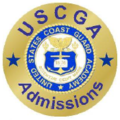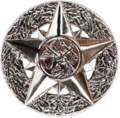
Identification badges of the uniformed services of the United States are insignia worn by service members conducting special duties, many of which can be awarded as permanent decorations if those duties are performed successfully. There are a few identification badges that are awarded to all services (such as the Presidential Service Badge), others are specific to a uniform service (such as the U.S. Army's Drill Sergeant Identification Badge). The Office of the President and Vice President and department/service headquarters badges are permanent decorations for those who successfully serve in those assignments. Some of the service level identification badges can be permanent decorations and others are only worn by a service member while performing specific duties, such as the Military Police Badge. [2] [3] [4] [5] [6] [7] [8] [9]
Contents
- Executive branch
- Department of Defense
- U.S. Army
- U.S. Marine Corps
- U.S. Navy
- U.S. Air Force
- U.S. Space Force
- Department of Homeland Security
- U.S. Coast Guard
- Department of Health and Human Services
- U.S. Public Health Service Commissioned Corps
- Department of Commerce
- U.S. National Oceanic and Atmospheric Administration Commissioned Corps
- See also
- References
Command insignia/badges are another form of identification badge used to identify an officer or non-commissioned officer who is/was in command or in-charge of a unit. If the service member performs their leadership duties successfully, the command insignia/badge they wear can become a permanent uniform decoration regardless of their next assignment. [3] [4] [6] [9]
The following is a list of identification badges currently in use by the uniformed services:












































































